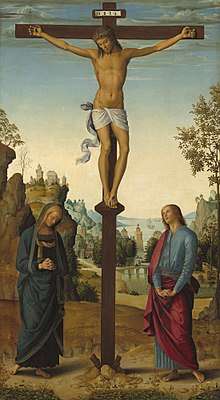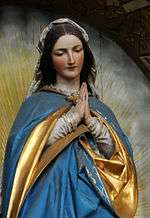Stabat Mater
The Stabat Mater is a 13th-century Christian hymn to Mary, which portrays her suffering as Jesus Christ's mother during his crucifixion. Its author may be either the Franciscan friar Jacopone da Todi or Pope Innocent III.[1][2][3] The title comes from its first line, "Stabat Mater dolorosa", which means "the sorrowful mother was standing".[4]

The hymn is sung at the liturgy on the memorial of Our Lady of Sorrows. The Stabat Mater has been set to music by many Western composers.
Date
The Stabat Mater has often been ascribed to Jacopone da Todi, OFM (ca. 1230–1306), but this has been strongly challenged by the discovery of the earliest notated copy of the Stabat Mater in a 13th-century gradual belonging to the Dominican nuns in Bologna (Museo Civico Medievale MS 518, fo. 200v-04r).[5]
The Stabat Mater was well known by the end of the 14th century and Georgius Stella wrote of its use in 1388, while other historians note its use later in the same century. In Provence, about 1399, it was used during the nine days' processions.[6]
As a liturgical sequence, the Stabat Mater was suppressed, along with hundreds of other sequences, by the Council of Trent, but restored to the missal by Pope Benedict XIII in 1727 for the Feast of the Seven Dolours of the Blessed Virgin Mary.[7]
Text and translation
The following translation by Edward Caswall is not literal, and represents the trochaic tetrameter rhyme scheme, and sense of the original text.
| Part of a series on the |
| Mariology of the Catholic Church |
|---|
 Virgo by Josef Moroder-Lusenberg |
|
|
|
|
|
|
|
1. Stabat mater dolorósa |
At the Cross her station keeping, |
Musical settings
Composers who have written settings of the Stabat Mater include:
- Josquin des Prez.[8]
- Orlande de Lassus (1585)
- Giovanni Pierluigi da Palestrina: Stabat Mater (c.1590).[8]
- Giovanni Felice Sances (1643)
- Marc-Antoine Charpentier H 15 & H 387 (1685-90)
- Louis-Nicolas Clérambault C. 70 (17..)
- Sébastien de Brossard SdB.8 (1702)
- Emanuele d'Astorga (1707)
- Antonio Vivaldi: Stabat Mater (1712)
- Domenico Scarlatti (1715)
- Nicola Fago (1719)
- Alessandro Scarlatti: Stabat Mater (1723).[8]
- Antonio Caldara (~1725)
- Agostino Steffani (1727)
- Giovanni Battista Pergolesi: Stabat Mater (1736).[8]
- Nicola Logroscino (1760)
- Joseph Haydn: Stabat Mater (1767).[8]
- Giuseppe Tartini (1769).[8]
- Tommaso Traetta (1770)
- Luigi Boccherini: Stabat Mater (1781, 1801)
- Franz Ignaz Beck (1782)
- Pasquale Cafaro (1784)
- Franz Schubert: Stabat Mater in G minor (1815) and Stabat Mater in F minor (1816)
- Gioachino Rossini: Stabat Mater (1831–1841)].[8]
- Peter Cornelius (1849)
- Franz Liszt: part of the oratorio Christus (1862–1866)
- Antonín Dvořák: Stabat Mater (1876–1877).[8]
- Josef Bohuslav Foerster: Op. 56 (1891–1892).[8]
- František Musil: Op. 50 (1893).[8]
- Giuseppe Verdi: Stabat Mater (1896–1897).[8]
- Toivo Kuula (1919)[9]
- George Oldroyd (1922)
- Karol Szymanowski: Stabat Mater (1925–1926).[8]
- Johann Nepomuk David (1927)
- Lennox Berkeley (1947)
- Francis Poulenc: Stabat Mater (1950)
- Krzysztof Penderecki: in St Luke Passion (1963–1966).[8]
- Arvo Pärt: Stabat Mater (1985)
- Knut Nystedt (1986)
- Trond Kverno (1991)
- Pawel Lukaszewski (1994)
- Vladimir Martynov (1994)
- Frank Ferko (1999)
- Vladimír Godár (2001)
- Bruno Coulais (2005)
- Karl Jenkins: Stabat Mater (2008)
- Paul Mealor (2009, revised 2010)
- Franco Simone (2014)
- James MacMillan (2015)[10]
Most of the settings are in Latin, but Karol Szymanowski's and Paul Bebenek's are in Polish, although Szymanowski's may also be sung in Latin. George Oldroyd's setting is in Latin but includes an English translation for Anglican/Episcopalian use.
See also
- Roman Catholic Mariology
References
- Sabatier, Paul Life of St. Francis Assisi Charles Scribner Press, NY, 1919, page 286
- The seven great hymns of the Mediaeval Church by Charles Cooper Nott 1868 ASIN: B003KCW2LA page 96
- p. 574, Alighieri, Durling, Martinez (2003) Dante, Robert M., Ronald L. Oxford The Divine Comedy of Dante Alighieri: Purgatorio Volume 2 of The Divine Comedy of Dante Alighieri Oxford University Press. "The Stabat Mater by the Franciscan Jacopone da Todi."
- Stabat Mater, Volume 68 by Girolamo Abos, Joseph Vella Bondin 2003 ISBN 0-89579-531-0 page xviii
- Cesarino Ruini, "Un antico versione dello Stabat Mater in un graduale delle Domenicane bolognesi," Deo è lo scrivano ch’el canto à ensegnato: Segni e simboli nella musica al tempo di Iacopone, Atti del Convegno internazionale, Collazzone, 7-8 luglio 2006, ed. Ernesto Sergio Mainoldi and Stefania Vitale, Philomusica On-line, 9, no. 3 (2010).
-

- Heartz, Daniel (1995). Haydn, Mozart and the Viennese School: 1740-1780. W.W. Norton & Co. p. 305. ISBN 0-393-03712-6. Retrieved 3 April 2011.
- Dvořák: Stabat Mater. Oratorio for Soloists, Chorus and Orchestra at Supraphon website.
- "Kuula - The ultimate Stabat Mater site". The ultimate Stabat Mater site. Retrieved 2018-04-06.
- "James MacMillan - Stabat Mater". Boosey & Hawkes. Retrieved 2017-04-14.
External links
| Wikisource has original text related to this article: |
- Website about (now) 250 different Stabat Mater compositions: information about the composers, the music and the text. The site also includes translations of the text in 20 languages.
- Several English translations
- Chant performed by "Exsurge Domine" vocal ensemble.
- Karol Szymanowski's "Stabat Mater". Spanish Radio and Television Symphony Orchestra. Thomas Dausgaard, conductor. Live concert.